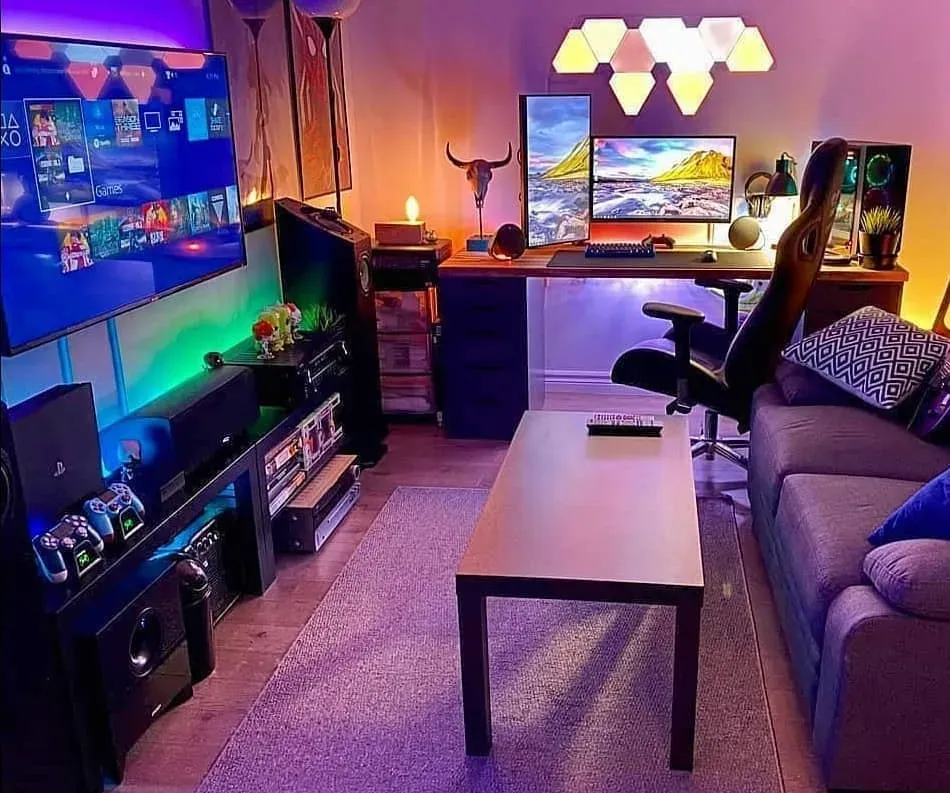Small space gaming setup blends efficiency, comfort, and style into a compact, high-performance station. A space-saving gaming setup makes the most of every inch, keeping essentials reachable without clutter. Pair a compact gaming desk with smart cable management to keep the surface clear while boosting performance, and consider gear that reflects the best gaming gear for small spaces. This introduction also hints at planning, layout ideas, and practical tips that translate to real rooms and budgets. If you’re looking for small space gaming room ideas, this guide offers practical steps on how to organize a tiny gaming nook.
Think of it as a compact gaming zone optimized for efficiency rather than footprint, a cozy tiny gaming nook that still feels expansive. This space-efficient layout centers on a minimalist workstation with wall-mounted displays to preserve surface area. By prioritizing ergonomic seating, tidy cable management, and smart storage, you can create a high-performance setup that fits apartments, dorms, and other tight spaces.
Small space gaming setup Mastery: Efficient Layout and Gear for Compact Rooms
In cramped quarters, every inch matters, and a Small space gaming setup becomes a showcase of deliberate design. Start by measuring width, depth, and height, then map obstacles like doors and radiators, just as you would when exploring small space gaming room ideas. Establish a single focal point—a desk with one or two monitors, a comfortable chair, and a tidy cable run—to keep the space from feeling chaotic. By centering planning around one main zone, you preserve sightlines and airflow while making the room feel more expansive.
With a space-saving mindset, choose a compact gaming desk that offers enough elbow room yet a shallow footprint. Look for built-in cable management, a top that can support a keyboard and mouse, and a gap underneath to hide power strips. Pair this with a wall-mounted monitor or monitor arm to free desk space, embodying the space-saving gaming setup ethos. If you have a smaller PC, a mini-ITX build or a compact console can pair neatly with a slim monitor and still deliver strong performance—the right gear should balance footprint with comfort.
Vertical storage and modular layouts help keep clutter at bay. Install floating shelves, use under-desk drawers, and consider a corner desk layout (an L-shape) to wrap around your focal point without crowding the floor. For ventilation, leave a small gap behind the desk and choose a compact case with decent airflow. A well-planned layout lets you enjoy immersive gaming without sacrificing roominess.
Best Gaming Gear for Small Spaces: Selecting Components that Maximize Footprint
When you’re chasing the best gaming gear for small spaces, prioritize components that deliver performance in a reduced footprint. Start with a small form factor PC or compact console, a high-refresh-monitor on a wall mount, and wireless peripherals to cut cable clutter. By focusing on compact gaming gear instead of chasing every latest gadget, you maintain speed and reliability without sacrificing space.
Choose a compact keyboard and mouse with low-profile designs, and consider a single, robust desk with integrated cable management to keep the surface clean. For tiny gaming nooks, a compact desk and wall-mounted peripherals let you reach for a controller or keyboard without expanding the base footprint. A typical setup benefits from a shared cable run and a centralized charging hub, which supports longer sessions without tangling everything.
To organize a tiny gaming nook efficiently, store infrequently used items out of sight and use vertical storage for accessories, games, and literature. Keep frequently used items within arm’s reach and label cables to speed swaps or upgrades. The result is a durable, scalable system where the gear remains powerful, but the room never feels overwhelmed.
Frequently Asked Questions
How can you design a Small space gaming setup in a small room using small space gaming room ideas and a compact gaming desk?
Begin with careful planning: measure width, depth, and height, then pick a single focal point (monitor(s) and keyboard) to avoid clutter. Implement small space gaming room ideas by using a wall-mounted monitor and a compact gaming desk to free surface area. Opt for a space-saving gaming setup with a small form factor PC or compact console and a slim, cable-managed desk. Finish with an ergonomic chair and proper airflow to keep comfort high without sacrificing performance.
What should you consider for the best gaming gear for small spaces when configuring a Small space gaming setup?
Prioritize compact components that maximize performance per footprint. Seek the best gaming gear for small spaces like a small form factor PC or compact console, a high-refresh-rate monitor mounted to the wall, and a wireless keyboard and mouse to cut cable clutter. Pair this with a compact gaming desk that includes cable management and supports ergonomic positioning, so your Small space gaming setup stays organized and comfortable. Maintain good airflow by leaving space behind the desk and avoiding crowding the room. This approach also helps with how to organize a tiny gaming nook.
| Aspect | Key Points | Practical Tips |
|---|---|---|
| Planning foundation | Measure available width, depth, and height; note obstacles (doors, windows, radiator pipes); map the room and locate outlets, ethernet drops, and lighting; define a focal point | Draw a simple floor map; designate a single focal point (desk/monitor); plan for vertical space with wall-mounted solutions to free desk surface |
| Compact desk and space-saving essentials | Choose a compact desk with an extended top for keyboard/mouse but a shallow footprint; look for built-in cable management and a gap underneath | Select desks with cable routing channels; prefer built-in cable management or a gap underneath to hide power strips and adapters |
| PC and peripherals | Prioritize space-saving gear: small form factor PC or mini-ITX; slim monitor; compact keyboard/mouse; consider wireless options to reduce cables | Balance performance with footprint; use wireless peripherals if possible to minimize clutter; choose compact components that fit the space |
| Monitors, mounts, and seating | Wall-mounted monitor or monitor arm; potential for dual monitors (staggered or vertical); ergonomic chair that fits the footprint | Keep monitor at eye level; use wall mounts or arms to free desk space; select a compact chair with good lumbar support |
| Cable management, power, and airflow | Single accessible power strip; route cables through channels; label cables; use cable sleeves to group lines | Label cables; leave a small gap behind the desk for heat dissipation; choose a compact PC case with good intake/exhaust |
| Storage and organization | Under-desk drawers, wall-mounted shelves, and vertical organizers to keep the desk clear; create dedicated spots for essentials | Use a slim under-desk tray for controllers/cables; install floating shelves or wall racks for peripherals and games |
| Layout ideas | Consider an L-shaped desk or wall-mounted multi-monitor setup to maximize surface area; aim for an open feel with a compact desk | Keep only essential items within arm’s reach; tuck nonessential items behind doors or above eye level to reduce clutter |
| Lighting, acoustics, and ambiance | Bias lighting behind the monitor; adjustable desk lamp; acoustic panels or soft furnishings for noise control | Use lighting to reduce eye strain; choose a cohesive color palette and subtle textures to make the space feel larger |
| Practical tips and common pitfalls | Prioritize a single functional desk surface; maximize vertical storage; ensure cable management and a monitor mount; pick a comfortable chair | Avoid cluttered desks, oversized PCs in small cabinets, and neglected cables; plan for a balanced, efficient setup |
| Gear choices for small spaces (quick guide) | Compact components with solid performance: small form factor PC or compact console; high-refresh-rate monitor on a wall mount; compact keyboard/mouse; consider wireless where suitable | Curate a small, high-quality gear set you actually use; prioritize footprint efficiency and reliability |
| Putting it all together: workflow | Start with a clean slate; measure space for desk/monitor; install wall-mounted monitor or arm; place a compact desk with cable management; position the chair; route cables; add shelves; adjust lighting | Follow a step-by-step routine to implement; reassess spacing after adding shelves or peripherals; test for comfort and accessibility |
| The end result | A functional Small space gaming setup that feels expansive, with comfortable seating, clear sightlines, and efficient access to gear | Aim for an immersive experience without visual or physical clutter; ensure the space remains welcoming and easy to maintain |
Summary
Small space gaming setup success comes from thoughtful organization, smart layout, and purpose-built gear. Designing around a compact desk, wall-mounted displays, and clean cable management helps you build a powerful, comfortable rig in a tight room. Emphasize ergonomics, vertical storage, and good airflow to keep the space airy rather than cramped. With careful planning and sensible gear choices, you can enjoy immersive gaming without sacrificing aesthetics or budget. A well-executed Small space gaming setup feels expansive, focused, and ready for long sessions.


